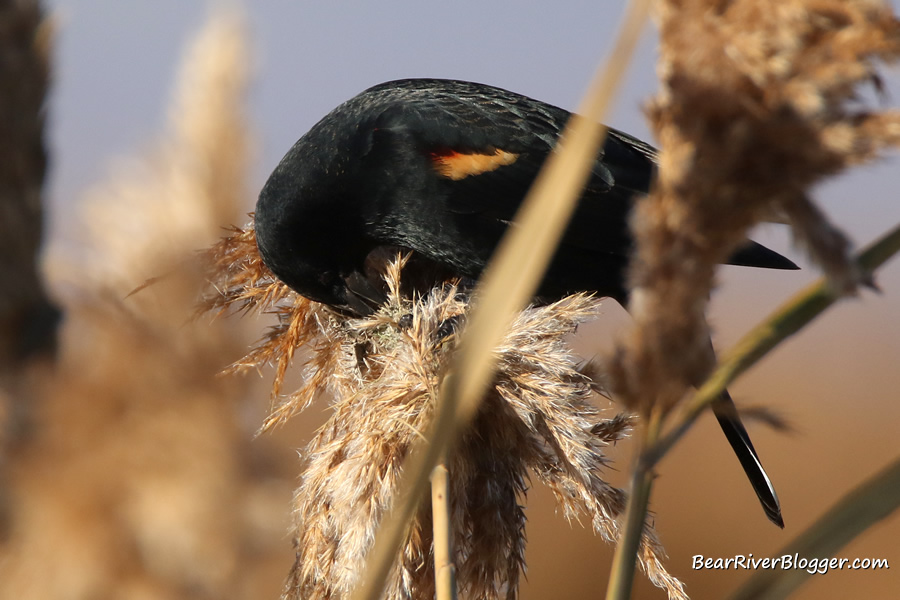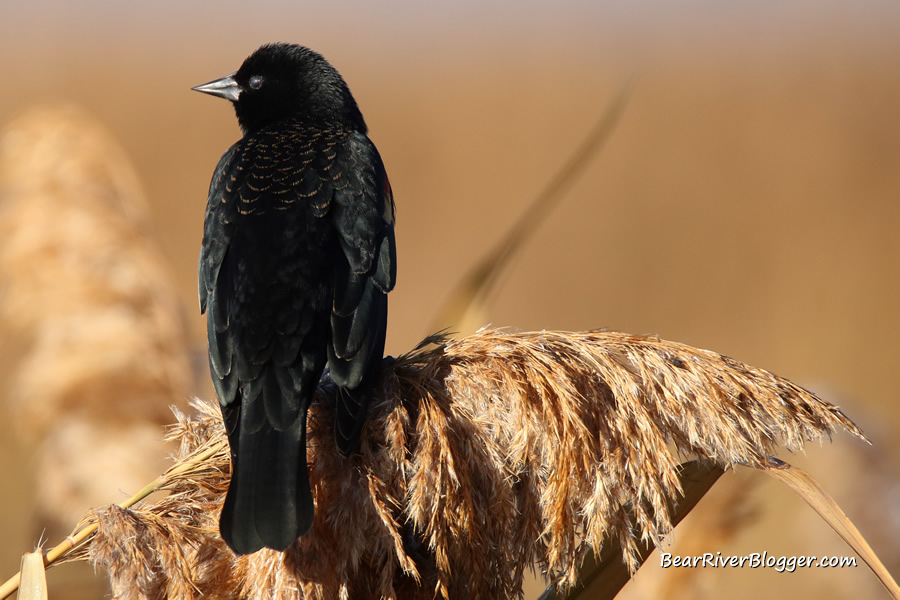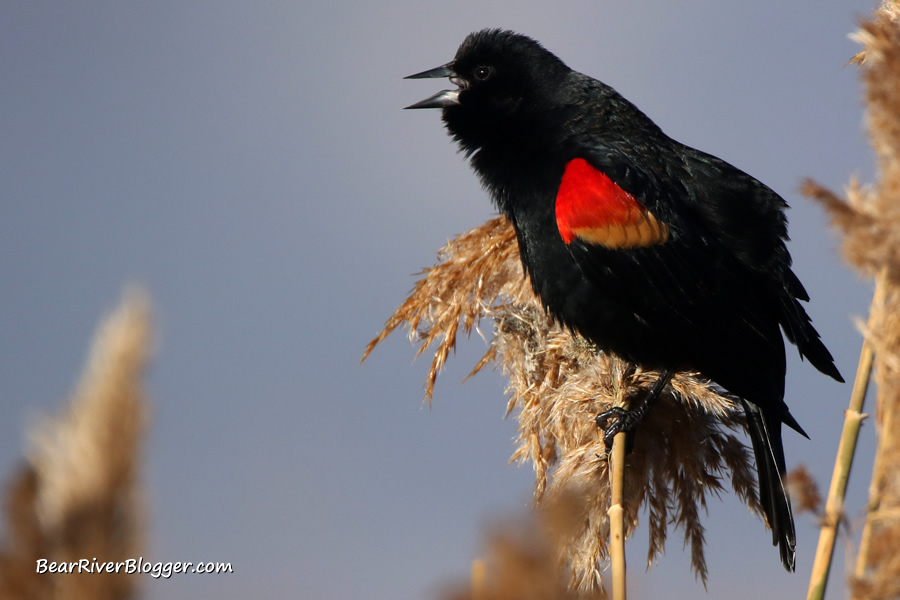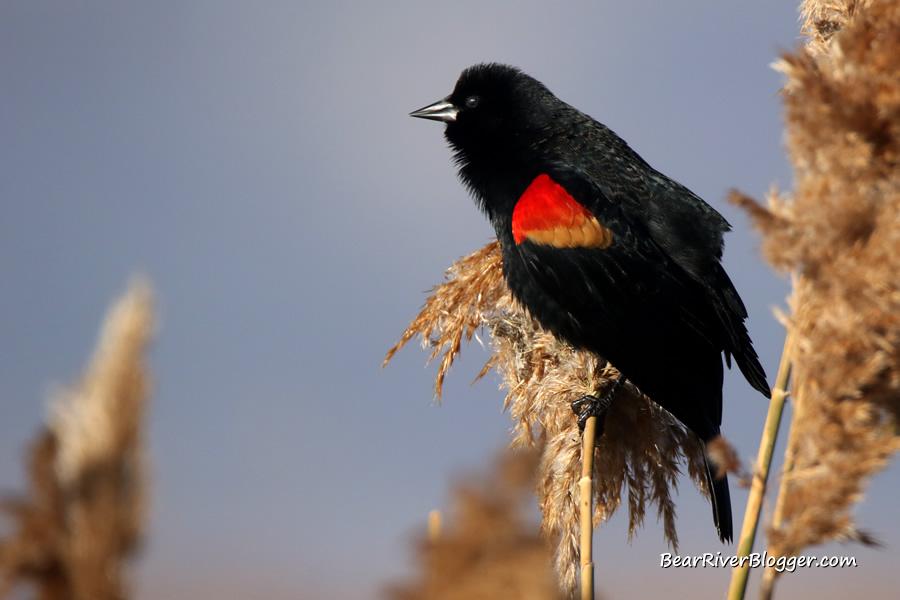Even though yesterday was a perfect setting for bird photography, a morning with no clouds coupled with great light, my birding efforts on the Bear River Migratory Bird Refuge auto tour route could only be described as, well, extremely slow at best, something that does happen at times on the refuge during hunting season mind you.
But despite this lackluster start to my day, I was, however, able to come home with a few images depicting three facts about red-winged blackbirds I hope you find interesting.
This particular birdwatching trip to the refuge was uncharacteristically shaping up to be so uneventful, so empty, at least for the first few miles of the drive it seemed, that I ended up parking along a wall of phragmites on the northwest corner of the 12-mile auto loop and watched a flock of red-winged blackbirds for nearly 30 minutes.
I typically don’t give anywhere near that much of my time and effort in one sitting during fall and winter to photographing red-winged blackbirds, partially due to their skittish nature outside of the breeding season, but there are a few random moments that cross my path, like yesterday, in fact, when these birds will intently grab and hold my attention for a spell.
My preference is to wait until spring when their mesmerizing mating song and courtship display are in full swing and it’s much easier to photograph the red-winged blackbird.
But with that said, I’m glad they caught my eye yesterday because the time I spent observing and photographing the blackbirds was most enlightening and somewhat educational, to say the least.
It didn’t take more than a few minutes to fully grab and hold my attention when a male red-winged blackbird approached and landed on a nearby phragmite stalk, seemingly offering himself as the subject for this entire blog post, in fact.
Red-winged Blackbirds Do Feed On Phragmites Seeds
Phragmites are a highly invasive, non-native plant that most, if not all, local wildlife managers believe offers little or no real benefit to birds here in Utah in the way of both food and nesting material.
It literally showed up on the Great Salt Lake wetlands out of the blue, including the Bear River bird refuge, shortly after the devastating floodwaters finally receded from the record-breaking winters of 1983-84 where salt water from the lake decimated and killed off the natural vegetation, leaving mostly barren mud flats where highly productive wetlands once thrived.
This gave the phragmites plant a kind of blank slate, for lack of a better term I’d say, to quickly get established in some areas and eventually spread, unabated of course, to most of the wetlands up and down the lakeshore.
From what I have read and heard from wildlife officials, phragmites offer no real food value for birds, but after my trip to the refuge yesterday there might be cause to slightly alter that notion somewhat.
Yesterday, as I was watching the male red-winged blackbird perched just a few short yards from me on a phragmites stalk I noticed this individual, and dozens more behind it mind you, was aggressively feeding on the dried seeds from the phragmites.

During fall and winter on the bird refuge, and I’m most certain on wetlands anywhere else for that matter, red-winged blackbirds feed upon seeds from cocklebur and other weeds that are still available this time of year and since the seed heads of phragmites share this same time frame, one where food is becoming a bit more limited with the impending winter season, it stands to reason blackbirds might have adapted a bit and are willing to feed upon these very plentiful and productive seed heads.
Even though the seeds themselves are extremely small it has been noted a single phragmites head can produce over 2,000 seeds, offering birds that are willing and able to partake a seemingly endless supply of food for the time being.
Now I’m not giving reason here to abandon the efforts to eradicate wetlands from this invasive plant, not in the least as natural wetland vegetation offers far better and more suitable habitat for all kinds of birds, but I will say that maybe, just maybe, it does offer some small benefit to birds that are willing to adapt to the changed landscape like the red-winged blackbird seemingly has done.
Red-winged Blackbirds Have A Third Eyelid (Nictitating Membrane)
I have written about other birds having a third eyelid, a nictitating membrane in other words, several times now but it is always rewarding to capture images of more and more species of birds showing this characteristic.
It wasn’t until I came home yesterday and started editing these images that I found yet another example of a bird showing their third eyelid, the male red-winged blackbird I was so intently watching and photographing for this blog post.

Most wild birds have this trait but it isn’t easily seen unless you’re lucky enough to capture a photograph or two when it is visible like I happened to do.
When it is covering the eye, the nictitating membrane, simply put, protects the bird’s eyeball from debris, dirt, and water and since a bird’s eyesight is its most critical sensory, it is easy to see why this functioning appendage is present in wild birds of many different species.
Male Red-winged Blackbirds Sing And Display During Fall
As I previously mentioned male red-winged blackbirds will vigorously perform their mating call and courtship display in spring and early summer in an effort to both attract a mate and defend their chosen territory from rival blackbirds.
The wetlands of the Bear River Migratory Bird Refuge, for example, are quite different once spring has arrived and their desire to sing is triggered by the ever-increasing amount of daylight that time of year.

But as the breeding season comes to a close, usually their singing and displaying routine drops off dramatically as well, only offering a short note or two in what seems to be a random offering during fall and winter so it was very odd to hear and watch numerous red-winged blackbirds routinely sing and display yesterday in this large patch of phragmites.
In fact, at times the male blackbird perched right in front of me started to show its bright red scapulars, feathers that cover the base of the wing, when another male blackbird was close by, a behavior commonly seen during spring among rival males but one I had never seen before or would even expect during fall or winter until yesterday.
Subscribe To Bear River Blogger
So there you have it, three interesting traits I found yesterday while birdwatching on the refuge, all from the same individual red-winged blackbird as well.
If you are fascinated with both birds, in particular, and nature, in general, I offer you to head on over to our subscribe page and sign up for email notifications for future blog posts similar to this one where we share our experiences while out in nature, both on and off of the famed Bear River Migratory Bird Refuge.
Follow Us On YouTube
(Red-winged Blackbird Singing. For short nature clips like this one and interesting stories about the natural world around us, check out our Bear River Blogger channel on YouTube for videos and updates from our travels while out in nature, both on and off of the famed Bear River Migratory Bird Refuge.)







